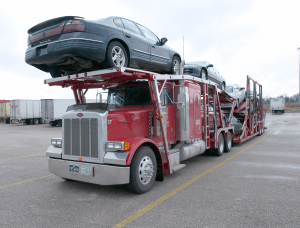Long Haul Trucking
November 28, 2014
Long haul truck driving can be defined as farther than 200-300 kilometres from the driver’s home terminal. Drivers operate a truck with a sleeper unit and in many instances, are gone for days at a time – and depending on the company, it can be two or three weeks.
If a company defines a driver as full-time, she may be allocated to one truck; otherwise, the driver slip seats, which means that she is in whichever truck is available for the trip.
Life on the Road
Consequently, driving truck becomes a lifestyle, not a job. Drivers shower and take their meals in truck stops, or prepare their own food in the truck using a microwave, protable BBQ or other device. Using toilets in rest areas become part of your daily reality.
Truck stops have changed over the decades, many offering movie lounges, games rooms and phones in comfortable booths. Today, the most common in the United States are the Pilot/Flying J Travel Centres.
Purchasing a set amount of fuel (often 100 gallons) gives the driver a free shower. Showers are assigned to drivers and for the time of their shower, drivers have access to her own personal bathroom. Trucks stops also offer parking, a convenience store, and restaurants.
GPS (Global Positioning Satellites)
Today, many trucking companies employ GPS tracking systems in their trucks. This system allows them to pinpoint the location of your truck at anytime via satellites and computer. This allows them to provide better customer service.
At one and the same time, there are numerous benefits to the driver. Prior to GPS tracking systems, drivers had to phone their dispatcher every hour when waiting for a load. This procedure undermined the driver’s sleep. The GPS tracking system in the truck is equipped with an alarm; when the dispatcher has a load for the driver to pickup, the GPS unit sounds the alarm. In some cases, drivers can access directions from the GPS system – either through a system similar to Google Maps, or by accessing a database where other driver’s have put in directions to a location. The system also has email capabilities.
Cross-Border
From British Columbia, most loads are transported to the United States, therefore drivers are required to have cross border knowledge, meaning that the load has to be cleared through American and Canadian customs – depending on which way your are traveling.
If you are working for a company that transports freight into the United States, you will be subjected to pre-employment and random drug & alcohol testing, as per American laws.
Pay
Most long-haul truck drivers are paid piecemeal. Trucking companies now pay approximately 30-40 cents/kilometer and many drivers average between 10,000 and 14,000 kilometres per month.
Long haul drivers often pull vans, but many operate flat decks, covered wagons, tankers and refrigerated trailers.
Teams
Some long haul companies operate dedicated runs, such as Quix X and Challenger out of Ontario. These companies that offer dedicated runs, often operate with team drivers. A team consists of two drivers that keep the truck moving 24-hours per day, except for breaks and fuel stops. Operating as a driver in a team environment is demanding, and many are not suited to such a position. Teams can drive 6,500 to 8000 kilometres per week.
(Photo by Randy Heinitz / CC BY)






